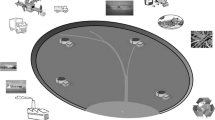Abstract
A variance-based global sensitivity analysis (GSA) was applied to the dose assessment model used in the risk-based corrective action methodology of environmental risk analysis to identify key sources of variability and uncertainty and quantify the relative contribution of these sources to the variance of estimated dose. GSA was performed applying extended Fourier amplitude sensitivity test technique. The soil-to-air contaminant transport pathway within an inhalation exposure scenario was addressed. Three persistent semi-volatile carcinogenic chemicals, including polychlorinated biphenyls, benzo(a)pyrene, and 2,3,7,8-tetrachlorodibenzo-p-dioxin, were chosen as contaminants of concern.







Similar content being viewed by others
References
Agenzia per la protezione dell'ambiente e per i servizi tecnici (APAT). (2002). ROME (v2.1) – ReasOnable Maximum Exposure.
Archer, G. E. B., Saltelli, A., & Sobol, I. M. (1997). Sensitivity measures, ANOVA-like techniques and the use of bootstrap. Journal of Statistical Computation and Simulation, 58, 99–120. doi:10.1080/00949659708811825.
Bennett, D. H., Kastenberg, W. E., & McKone, T. E. (1999). A multimedia, multiple pathway risk assessment of atrazine: The impact of age differenziated exposure including joint uncertainty and variability. Reliability Engineering & Systems Safety, 63, 185–198. doi:10.1016/S0951-8320(98)00046-5.
Connor, J. A., Newell, C. J. & Malander, M. W. (1996). Parameter estimation guidelines for Risk-Based Corrective Action (RBCA) modeling. In Proc. 3rd Conf. on Petroleum Hydrocarbons (NGWA) (p. 19). Houston, TX.
Cousins, I. T., Beck, A. J., & Jones, K. C. (1999). A review of the processes involved in the exchange of semi-volatile organic compounds (SVOC) across the air–soil interface. Science of the Total Environment, 228, 5–24. doi:10.1016/S0048-9697(99)00015-7.
Cukier, R. I., Levine, H. B., & Shuler, K. E. (1978). Nonlinear sensitivity analysis of multiparameter model systems. Journal of Computational Physics, 26, 1–42. doi:10.1016/0021-9991(78)90097-9.
E 1739-95 Standard guide for Risk-Based Corrective Action Applied at petroleum release sites. (2001). Annual Book of ASTM Standards vol. 11.04 (pp. 908–959). West Conshohocken, PA: American Society for Testing and Materials.
E 2081-00 Standard guide for Risk-Based Corrective Action. (2001). Annual Book of ASTM Standards vol. 11.04 (pp. 1164–1257). West Conshohocken, PA: American Society for Testing and Materials.
Groundwater Services, Inc. (2003). RBCA ToolKit for chemical releases (v1.3b).
Hertwich, E. G., McKone, T. E., & Peace, W. S. (2000). A systematic uncertainty analysis of an evaluative fate and exposure models. Risk Analysis, 20, 439–454. doi:10.1111/0272-4332.204043.
Joint Research Center of the European Commission. (2003). Simulation environment for uncertainty and sensitivity analysis. SIMLAB (v2.2), Ispra (VA), Italy.
Jury, W. A., Gardner, W. R., & Gardner,W. H. (Eds.) (1991). Soil physics, 5th edn. New York: Wiley.
Lu, Y., & Mohanty, S. (2001). Sensitivity analysis of a complex, proposed geologic waste disposal system using the Fourier amplitude sensitivity test method. Reliability Engineering & Systems Safety, 72, 275–291. doi:10.1016/S0951-8320(01)00020-5.
McKone, T. E. (1996). Alternative modeling approaches for contaminant fate in soils: uncertainty, variability and reliability. Reliability Engineering & Systems Safety, 54, 165–181. doi:10.1016/S0951-8320(96)00073-7.
Moschandreas, D. J., & Karuchit, S. (2002). Scenario-model-parameter: A new method of cumulative risk uncertainty analysis. Environment International, 28, 247–261. doi:10.1016/S0160-4120(02)00025-9.
Provincia di Milano, GIUDITTA© (v3.0). (2002). Gestione Informatizzata DI Tollerabilità Ambientale.
Rabitz, H., Alis, O. F., Shorter, J., & Shim, K. (1999). Efficient input-output model representations. Computer Physics Communications, 117, 11–20. doi:10.1016/S0010-4655(98)00152-0.
Saltelli, A., Chan, K., & Scott, M. (Eds.). (2000). Sensitivity analysis. New York: Wiley.
Saltelli, A., Tarantola, S., & Campolongo, F. (2000). Sensitivity analysis as an ingredient for modeling. Statistical Science, 13, 377–395.
Saltelli, A., Tarantola, S., & Chan, K. (1999). A quantitative, model independent method for global sensitivity analysis of model output. Technometrics, 41, 39–56. doi:10.2307/1270993.
Sobol, I. M. (1993). Sensitivity analysis for nonlinear mathematical models. Mathematical Modeling and Computational Experiment, 1, 407–414.
Travis, C. C., Obenshain, K. R., Regens, J. L., & Whipple, C. G. (2001). Limitations of multimedia model for use in environmental decision making. Environmental Monitoring and Assessment, 71, 51–60. doi:10.1023/A:1011691628387.
US Environmental Protection Agency (EPA). (1992). Guidelines for exposure assessment. EPA/600/Z-92/001, May.
US Environmental Protection Agency (1995). Use of Risk-Based Decision-Making in UST Corrective Action Programs, US OSWER, Directive 9610.17, March.
US Environmental Protection Agency (EPA). (1996). Soil screening guidance: Technical background document, EPA/540/R-95/128, May.
US Environmental Protection Agency (EPA). (1997). Guiding principles for Monte Carlo analysis. EPA/630/R-97/001, March.
US Environmental Protection Agency (EPA). (2001). Process for conducting probabilistic risk assessment. Risk Assessment Guidance for Superfund (RAGS), vol. III-Part A, EPA/540/R-02/002, December.
US Environmental Protection Agency (EPA). (2003). Example exposure scenarios. National Center for Environmental Assessment, Washington, DC; EPA/600/R-03/036.
Waterloo Hydrogeologic. (2003). Risk workbench (v4.03).
Acknowledgments
The authors would like to acknowledge the support, the assistance, and the insights of Carlo Cremisini, Head of Section for Environmental Evaluation Methods Development of ENEA. We also wish to thank Giuseppe Di Landa who contributed to the manuscript revision.
Author information
Authors and Affiliations
Corresponding author
Rights and permissions
About this article
Cite this article
Avagliano, S., Parrella, L. Managing Uncertainty in Risk-Based Corrective Action Design: Global Sensitivity Analysis of Contaminant Fate and Exposure Models Used in the Dose Assessment. Environ Model Assess 14, 47–57 (2009). https://doi.org/10.1007/s10666-008-9163-5
Received:
Accepted:
Published:
Issue Date:
DOI: https://doi.org/10.1007/s10666-008-9163-5




